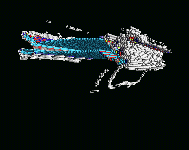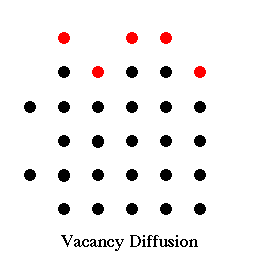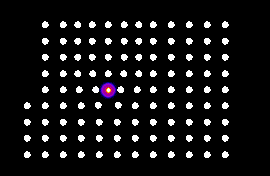Lab 1a-Deformation Mechanisms
VIEPS/Mainz Microstructure Course
| TOC | Lecture 1
2 3
4 a b
5 a b
| Lab 1 a b
c 2 a
b c 3
a b 4
a b 5
a b|
Glossary Table1
2 3
4 5
Index |
Further Reading:
An Outline of Structural Geology, 1976. Hobbs, Means & Williams
p 73-104
Crystalline Plasticity and Solid State Flow in Metamorphic Rocks,
1976 Nicholas & Poirier p 52-121
Creep of Crystals, 1985 Poirier p 38-63
Microtectonics, 1996, C. W. Passchier & R.A.J. Trouw,
Springer-Verlag, Berlin.
1) Computer simulations and animations of
deformation mechanisms.
The first part of the lab consists of
a series of computer animations of various small scale deformation
mechanisms.
To view the images in this course as a movie, click on the right arrow
at the bottom left of the picture (or fast forward and reverse with the
arrows on the lower right hand side).
A) Molecular Dynamics Simulations.
These are numerical simulations where the interactions between atoms in a crystal are calculated for systems typically with 100x100x100 atoms. These allow the investigation of VERY small scale deformation processes.
In the movie below, the dislocations generated around a crack tip have
been modelled numerically by a technique known as non-equilibrium molecular
dynamics. In this technique the interactions between atoms are modelled,
and the visualisation shows only those atoms with high energy states (ie
near dislocations). The big loops that develop near the crack tip are typical
of real dislocations. Further information on this study can be found in
(S. J. Zhou, et al., Physical Review Letters, 78, 1997).
- If these simulations have 10 million atoms in them, how many times larger would they have to be to simulate a single 1 mm cube of quartz? (You will have to find lattice cell parameters for quartz from a mineralogy text book). Similarly these simulations run at strain rates of 10+8s-1, how many orders of magnitude is this from a "geological" strain rate?

B) Dislocation Dynamics Simulations
Graphical Animations of Processes
- Explain how each process below leads to the straining
and formation of microstructures in the crystals.
C) Vacancy migration. In this movie we see a small rectangular crystal
change its shape via the motion of vacancies through the crystal. Notice
how the last vacancy takes a very circuitous route through the crystal,
which is in fact an under-representation of the amount of random diffusional
motion that would actually take place.
-
What might cause a non-random motion of vacancies
in a natural crystal?

D) Edge Dislocations Motion. In these movies a single horizontal glide plane
is activated by elastic strain build up in a crystal. Watch as the lattice
bonds in the glide plane get stretched, and then switch one by one to a
new orientation, and then once the dislocation has passed through the crystal,
how this allows the further slip of the crystal on the glide plane.
-
Notice how the distortion of the lattice is restricted to a small area
around the tip of the extra half plane. This zone of elastic distortion
(known as the dislocation core) is a fast diffusional pathway for fluid migration,
and also provides the driving force for various other deformation processes
-
Notice also that in this cubic symmetry crystal another perpendicular slip
system may well be active at the same time, to say nothing of possible
slip systems at 45 degrees to the existing one.
 For both screw and edge dislocations the unit displacement of the crystal lattice is
known as the Burgers vector.
For both screw and edge dislocations the unit displacement of the crystal lattice is
known as the Burgers vector.
F) Dislocation loops and Frank-Reed Sources of
Dislocations. If you have a dislocation which forms a complete loop, the loop
diameter can grow as a shear stress is applied, causing strain in the crystal.
How do new dislocations form? Well one really good way of generating an endless supply of dislocations
is to have a Frank-Read source, which you have already seen above, which is really just a glide plane with
two sticking points on it at which a glissile dislocation sticks. The stress
on the initially straight dislocation bends it out until it bends so far
around it joins up with itself and forms a closed loop, which then just
grows in size. The remaining pinned dislocation then starts again and generates
an endless supply of free loops.
This type of source will necessarily result in a concentration of slip
on just a few planes, rather than even glide throughout the body of the
crystal, and this is what is seen in experimental deformation of single
crystals.
G) Tilt-wall formation. This movie of
ice
deformation made by Chris Wilson has us looking side on on a
bending crystal, and shows the initial bending of a crystal (eg the light green grain in the
top-left), with the regeneration
of perfect crystal by the addition of dislocations of the same sign to
a developing sub-grain (tilt wall boundary). This process will convert
a grain showing an undulatory extinction microstructure to one with a sub-grain
microstructure.
-
In the same grain a twist wall boundary forms on the left hand side. How do we know this is a twist boundary (assuming that only basal glide is active)?
- What would happen if two tilt-wall sub-grain boundaries
with the same sign coalesce? What would happen if two tilt-wall sub-grain
boundaries with the opposite sign coalesce?
H) Twinning. In this example from Janos Urai, the limited nature of twinning is
exposed: one a crystal has twinned in a certain orientation, it cannot
accommodate more strain, although you do see more than one twin set is activated in this crystal. You could un-twin it by changing the stress orientation,
but otherwise twinning is fixed in both the incremental amount and the
total amount of strain that can be achieved. Nevertheless twinning is a
very important low temperature-low strain deformation mechanisms in calcite.
-
How could you distinguish a kink band from a twin
in a natural crystal.
VIEPS/Mainz Deformation Microstructures Course Lab 1 - Deformation
Mechanisms
Copyright Mark Jessell & Paul Bons 2000



